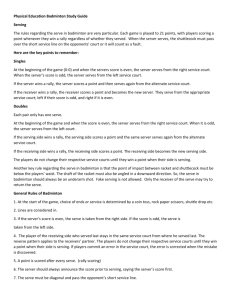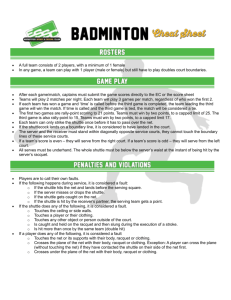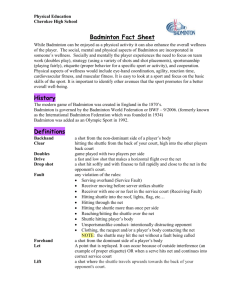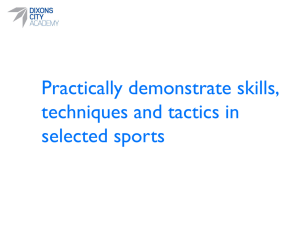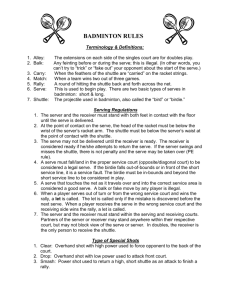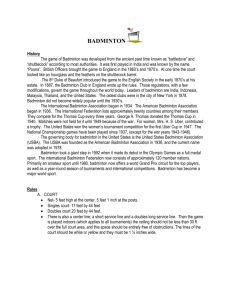badninton unit study guide new 2
advertisement
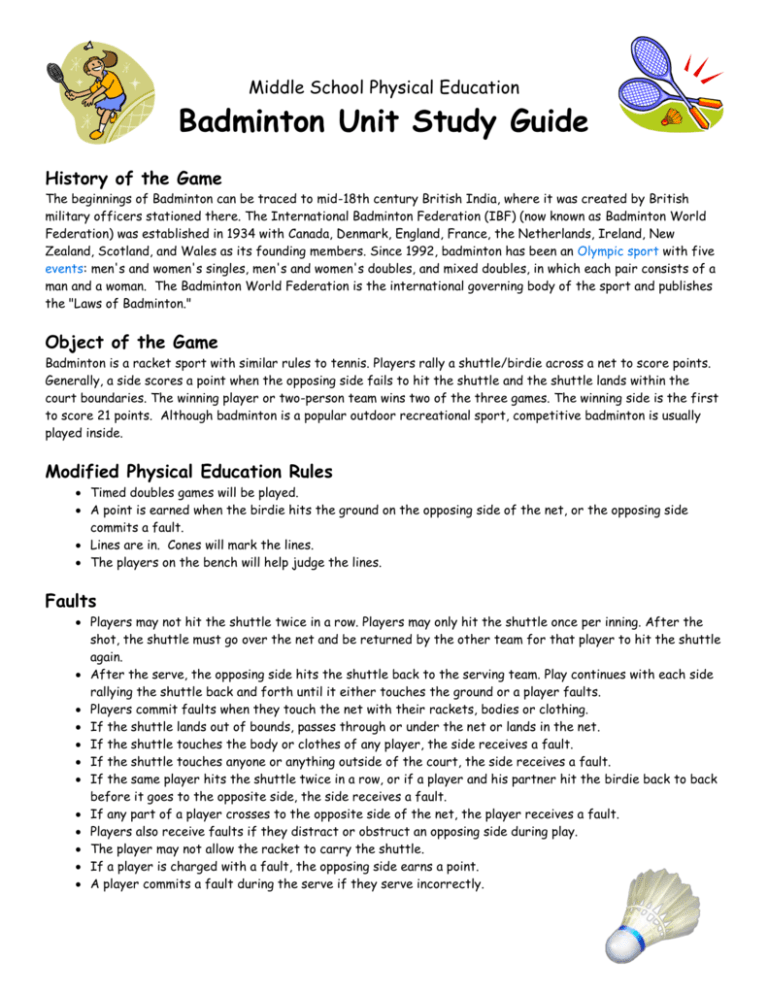
Middle School Physical Education Badminton Unit Study Guide History of the Game The beginnings of Badminton can be traced to mid-18th century British India, where it was created by British military officers stationed there. The International Badminton Federation (IBF) (now known as Badminton World Federation) was established in 1934 with Canada, Denmark, England, France, the Netherlands, Ireland, New Zealand, Scotland, and Wales as its founding members. Since 1992, badminton has been an Olympic sport with five events: men's and women's singles, men's and women's doubles, and mixed doubles, in which each pair consists of a man and a woman. The Badminton World Federation is the international governing body of the sport and publishes the "Laws of Badminton." Object of the Game Badminton is a racket sport with similar rules to tennis. Players rally a shuttle/birdie across a net to score points. Generally, a side scores a point when the opposing side fails to hit the shuttle and the shuttle lands within the court boundaries. The winning player or two-person team wins two of the three games. The winning side is the first to score 21 points. Although badminton is a popular outdoor recreational sport, competitive badminton is usually played inside. Modified Physical Education Rules Timed doubles games will be played. A point is earned when the birdie hits the ground on the opposing side of the net, or the opposing side commits a fault. Lines are in. Cones will mark the lines. The players on the bench will help judge the lines. Faults Players may not hit the shuttle twice in a row. Players may only hit the shuttle once per inning. After the shot, the shuttle must go over the net and be returned by the other team for that player to hit the shuttle again. After the serve, the opposing side hits the shuttle back to the serving team. Play continues with each side rallying the shuttle back and forth until it either touches the ground or a player faults. Players commit faults when they touch the net with their rackets, bodies or clothing. If the shuttle lands out of bounds, passes through or under the net or lands in the net. If the shuttle touches the body or clothes of any player, the side receives a fault. If the shuttle touches anyone or anything outside of the court, the side receives a fault. If the same player hits the shuttle twice in a row, or if a player and his partner hit the birdie back to back before it goes to the opposite side, the side receives a fault. If any part of a player crosses to the opposite side of the net, the player receives a fault. Players also receive faults if they distract or obstruct an opposing side during play. The player may not allow the racket to carry the shuttle. If a player is charged with a fault, the opposing side earns a point. A player commits a fault during the serve if they serve incorrectly. Serving The serving player and the receiving player stand diagonally opposite each other. The serve must move across the net diagonally in order to be a good play. The serve is underhand and hit below the waist. If the receiver is not ready when the service is delivered, a let shall be called; yet, if the receiver attempts to return the shuttle, he shall be judged to have been ready. The serving side serves from the right side of the court when that side has no points or an even number of points. The serving side serves from the left side of the court when that side has an odd number of points. The player with the right to serve is the last player or side who scored a point. In doubles play, serving rotates between all four players in a specified order. Either the serving or receiving player can earn a point during a rally. Safety Rules Communicate with your teammates. Do not touch the net or go over the net. Do not swing the racquet near your team mate. Remain on your feet at all times. Grip your racquet firmly. Etiquette Badminton etiquette is essential for the sport to be fun and fair. Players should call their own illegal shots and return the shuttle in a gentle manner for the next serve, according to Official Badminton. Each server should state the score before serving, their own score first. After the match is over, the opponents should shake hands. Strategy Both pairs will try to gain and maintain the attack, smashing downwards when possible. In doubles, players generally smash to the middle ground between two players in order to take advantage of confusion and clashes. At high levels of play, the backhand serve has become popular to the extent that forehand serves have become fairly rare at a high level of play. The straight low serve is used most frequently, in an attempt to prevent the opponents gaining the attack immediately. Flick serves are used to prevent the opponent from anticipating the low serve and attacking it decisively. Be in a ready position. Hit to the open space. Don’t be predictable. 6/2011
